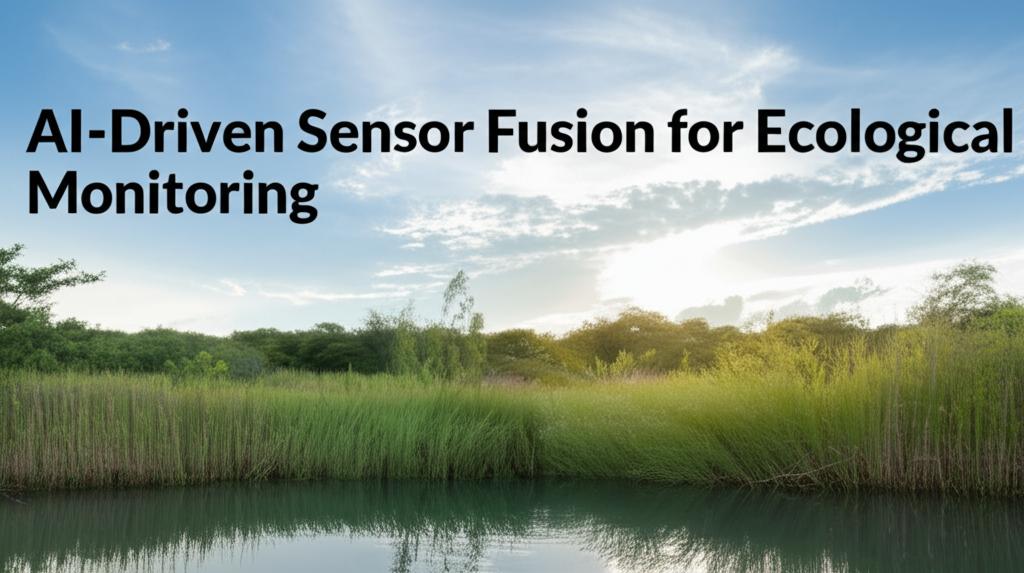Sensor fusion technology integrates data from multiple diverse sensors to create a more comprehensive and accurate understanding of an environment or system than any single sensor could provide alone. When applied to ecological monitoring, this involves combining information from sources like ground-based sensors (measuring temperature, humidity, soil moisture, chemical properties), remote sensing data (satellite imagery, LiDAR), acoustic sensors, camera traps, and Internet of Things (IoT) devices.
The integration of Artificial Intelligence (AI), particularly machine learning (ML) and deep learning, significantly enhances the capabilities of sensor fusion for ecological monitoring. AI algorithms excel at processing the vast and complex datasets generated by multiple sensors. They can identify subtle patterns, correlations, and anomalies that might be missed by traditional analysis methods. This allows for a deeper understanding of ecosystem dynamics, species behavior, and environmental changes.
AI-driven sensor fusion offers numerous benefits for ecological monitoring. It enhances data precision and reliability by cross-validating information from different sensors and mitigating the limitations or potential failures of individual sensors. This leads to more robust and accurate assessments. Automation powered by AI streamlines data collection and analysis, making monitoring processes faster, more efficient, and often more cost-effective than traditional labor-intensive methods. AI enables real-time analysis and interpretation of fused sensor data, facilitating timely interventions and informed decision-making for conservation and environmental management. Furthermore, predictive analytics, a key capability of AI, allows for forecasting future environmental conditions, such as pollution events, climate anomalies, wildlife population changes, or potential natural disasters, enabling proactive management strategies.
The process typically involves collecting data streams from various deployed sensors, including satellite imagery, IoT networks, ground surveys, and specialized devices like camera traps or environmental DNA (eDNA) samplers. These diverse data types, which can vary in format, resolution, and frequency, are then integrated using sophisticated data fusion techniques. AI algorithms are applied to this fused data for analysis. Supervised learning models might classify land cover types or identify species, unsupervised learning can detect anomalies in environmental parameters, and deep learning models, like Convolutional Neural Networks (CNNs), are particularly effective for analyzing image data from satellites or camera traps. Techniques like multi-modal learning allow AI to effectively combine different data types (e.g., images and sensor readings) for richer insights.
This technology is transforming various ecological monitoring applications. In biodiversity conservation, AI analyzes fused data from camera traps, acoustic sensors, and satellite imagery to automate species identification, monitor wildlife populations and movements, map habitats, and assess ecosystem health. For environmental quality monitoring, AI-powered sensor networks track air and water pollution in real-time, identify pollution sources, and predict contamination events, supporting quicker responses to protect human and environmental health. It's also vital in climate change research, where AI analyzes fused data from satellites, weather stations, and ocean sensors to improve climate models, track long-term trends like deforestation or sea-level rise, and assess climate impacts on ecosystems. AI can also optimize resource management by analysing sensor data to guide strategies for sustainable agriculture, forestry, or water usage.
Despite its potential, challenges remain. Ensuring high data quality from diverse sensors, often deployed in harsh environments, is crucial, as AI outputs are only as good as the input data. Issues like missing values, noise, and sensor drift need addressing. Integrating data from heterogeneous sources requires standardization and harmonization. The computational complexity of processing vast datasets and running sophisticated AI algorithms, especially for real-time applications, can be demanding. Security and privacy concerns, particularly with widespread sensor deployment, and ethical considerations regarding data use must also be managed.
The future points towards even more sophisticated applications. Advancements in AI algorithms, including explainable AI (XAI) to improve transparency, are ongoing. Integrating sensor fusion with edge computing allows for data processing closer to the source, reducing latency for real-time responses. The combination with technologies like blockchain could enhance data security and traceability. Expanding citizen science initiatives, empowered by user-friendly AI tools and IoT devices, can significantly broaden data collection efforts. Ultimately, AI-driven sensor fusion promises increasingly powerful tools for understanding, protecting, and sustainably managing our planet's ecosystems.

